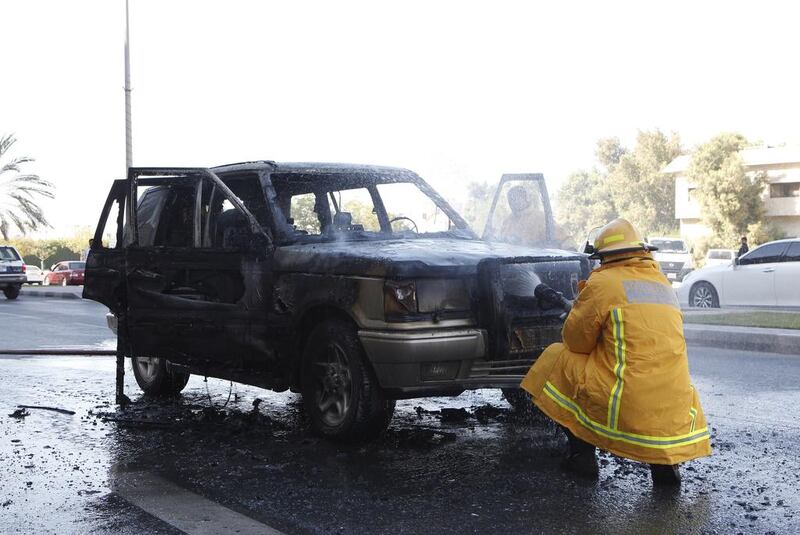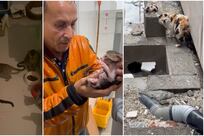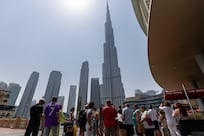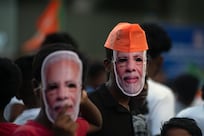ABU DHABI // Motorists have been urged to look after their cars properly after a series of incidents in which vehicles went up in flames this summer.
Improper mechanical and electrical maintenance, filling up with petrol while the engine is running, using tyres that exceed the manufacturer's specifications and poor driving behaviour were the main causes of vehicle fires, experts warned.
“Most drivers underestimate fire hazards in motor vehicles,” said Dr Salaheddine Bendak, an associate professor in industrial engineering at the University of Sharjah. “A simple example of this issue is smoking in petrol stations.
“Although no smoking signs are in most, if not all, petrol stations, we still see people smoking, ignoring the potential fire and explosion hazards.”
Despite the high risk of cars catching fire at petrol stations, it was not uncommon to see vehicles with engines running while they were being filled up, he said.
There were reports of attendants being verbally abused or physically assaulted when they asked motorists to turn off their engines.
“People should drive carefully, switch off their engines while refuelling and should not smoke within petrol stations,” Dr Bendak said.
Not keeping everything in order under the bonnet also poses a fire risk, particularly in the heat of the UAE, he said.
“Car fires could be prevented if cars are maintained properly,” said Dr Bendak.
Reducing the risks of vehicle fires also required good driving standards.
Driver training and education coupled with good road policing is needed, said Ian Evans, principal electrical engineer at Harmonic Solutions Oil and Gas in Ras Al Khaimah.
Vehicle fires resulting from crashes or collisions can be the most dangerous, he warned.
Often the fuel tanks can be damaged and leak and sometimes the vehicle’s occupants were trapped.
“Drivers should get off the phone, maintain a safe distance between vehicles, use indicators to let other drivers know their intention before they move and all occupants should wear seat belts,” Mr Evans said.
“In the United Kingdom, as learners it is drummed in to us, ‘mirror, signal, manoeuvre’. Here it is the other way around.”
Dr Bendak also urged drivers to be more vigilant and courteous. "Drivers should avoid tailgating, drive within the speed limit, avoid using electronic devices and having heated conversations while driving," he said, adding that keeping a fire extinguisher in the vehicle was also a good idea.
However, fire extinguishers were not much help if the extinguisher was out of date or a motorist did not know how to use it, said Mr Evans, who would like more training for motorists.
“Drivers here should be made aware of the causes of vehicle fires,” he said.
“If a fuse blows, do not replace it with a bigger one. Investigate the cause and use the correct rated fuse for the circuit. If in doubt, take the car to the garage or auto electrician to resolve the problem.”
The experts’ advice was prompted by the series of vehicle fires in the UAE this summer, see box.
_____
Vehicle fires this year:
February 19: A fire broke out in diesel tanks in Al Sajaa Industrial Area in Sharjah. Two people were injured.
February 21: A fire destroyed 19 vehicles in the car park of Sharjah University's women's campus. No injuries were reported.
March 3: A 51-year-old Emirati man died in a collision between two vehicles on Sheikh Mohammed bin Zayed Road in Ajman. He was driving towards Sharjah when another vehicle entered his path. The car rolled over four times before catching fire.
May 19: A 31-year-old Egyptian motorist died after two lorries crashed into each other on the Masafi Al Dhaid Road in Sharjah.
July 7: An Emirati died after the vehicle he was driving swerved and crashed into a lamppost, then caught fire, in Ras Al Khaimah.
July 18: An Emirati woman died in a collision on Sheikh Khalifa Highway. The woman crashed into a lorry on the Dubai-bound side, causing both vehicles to catch fire.
July 20: A child was killed and 23 people were injured in Sharjah when their bus swerved out of control and caught fire. The bus flipped on to its side before it burst into flames in Wadi Al Helo, Kalba.
rruiz@thenational.ae






